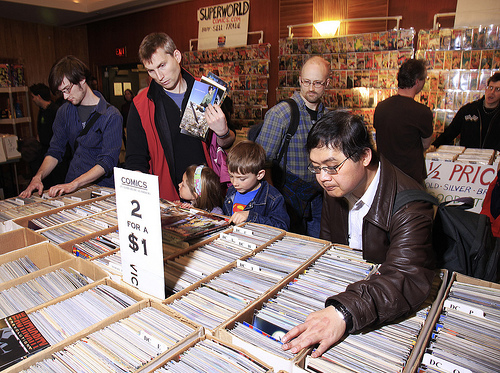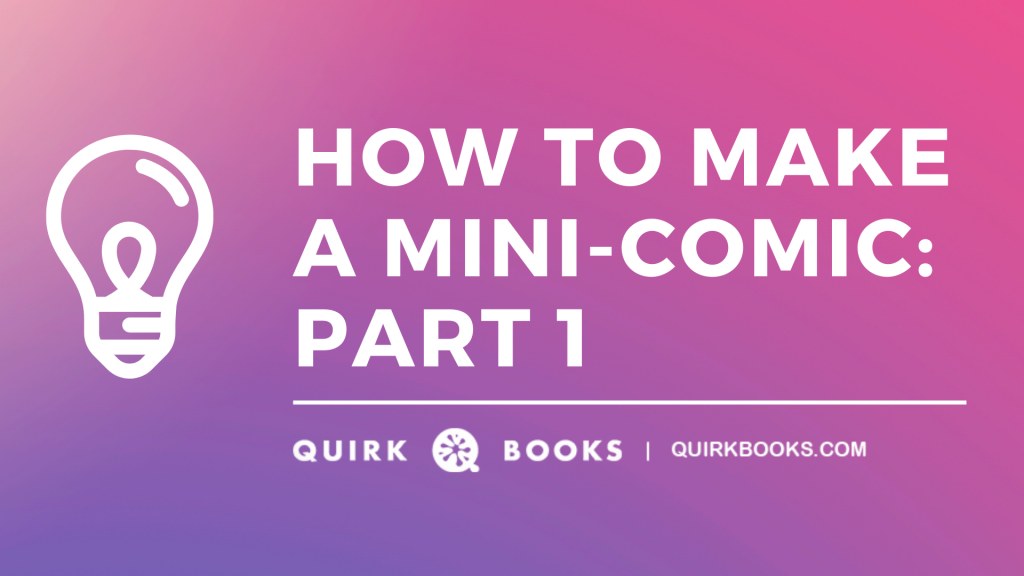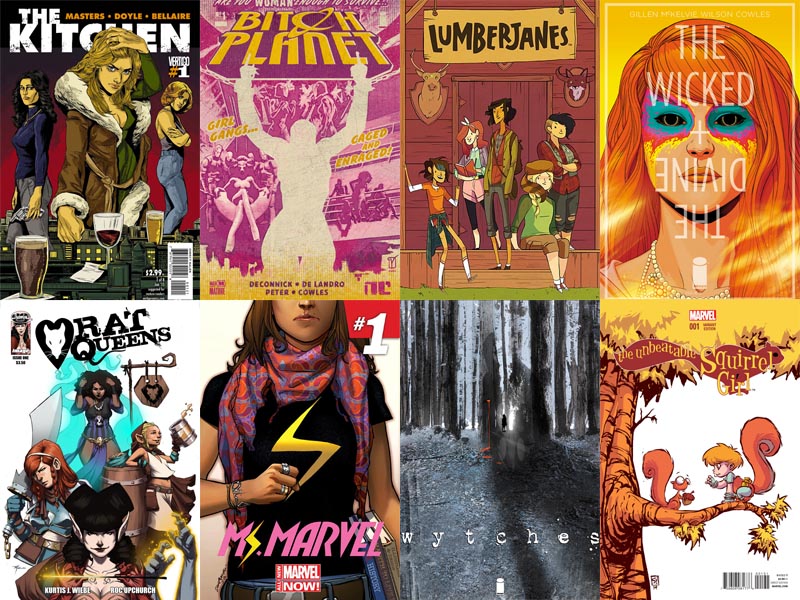(Image via Flickr)
How many times have you decided to start watching a new television series, only to have it cancelled after a season—or worse, after a precious handful of episodes? The history of television is littered with series that were unfairly cut off at the knees: we all mourn Millennium, Crusade, Birds of Prey and, of course, Firefly. But how many of us can name an equally ill-fated comic series?
X-Men, Superman, and Batman, will go on forever, regardless if anyone actually reads them, and mid-list series like Teen Titans, Swamp Thing, and Young Avengers will stick around for a few good years. But some books seem to have the deck stacked against them from the get-go. Niche subjects and storylines can be successful, but for every Sandman, Bone, The Walking Dead or even Hellblazer, there are scores of series that disappeared as fast as they arrived. These are titles that don't fit the “superhero” mold, or that buck even the most alternative of trends. These are the miniseries that never get collected as trade-paperback filler for quarter bins at Wizard World.
Still, I can practically guarantee that every gone-too-soon series was someone's favorite. Commercial success or no, most of these books feature ideas that will intrigue you, writing that will make you think, and artwork that will dazzle and impress. With that in mind, I present six series, unfairly forgotten in the mists of most fanboys' minds but still quite worthy of admiration and investigation.
ATARI FORCE (1984, DC Comics): Atari Force—a sequel to the original mini-comics included with various Atari video games in the early 80's—was a monthly series published by DC Comics from 1984 to 1985. Lasting only twenty issues, it followed the adventures of Martin Champion and his new Atari Force as they battled the evil Dark Destroyer across the galaxy. Featuring the talents of Gerry Conway, Mike Baron, Ross Andru, Eduardo Barreto, it also included some of the first work from Jose Luis Garcia-Lopez, who later enjoyed a prolific career with flagship DC franchises.
Even though Atari Force was, in essence, a video game tie-in comic, it still had some of the best writing and art on the stands at the time. It was doing science-fiction, and doing it well, at a time when almost no one else was. Plus, it had the benefit of being a stand-alone series that you could read without having to follow any of DC's other titles. Alas, Atari Force was no match for the onslaught of illustrious contemporary releases like Watchmen, The Dark Knight Returns and Crisis on Infinite Earths. But for those of us who followed the series when it came out, it was a great ride that we were all sorry to see end.

Ted McKeever's METROPOL (1991, Epic Comics): Of all the books that came out of Marvel's creator-owned Epic imprint in the 1990's, none was like Metropol. From the darkly humorous mind of Ted McKeever, the book told the story of Jasper Notochord and his involvement in an epic battle of good versus evil set against an urban industrial landscape. The writing was stark and evocative, and when added to McKeever's distinctive artwork, made Metropol unique even among other alternative comics.
Thankfully, despite a tone that was decidedly left of normal, McKeever got to tell the entire Metropol story over the course of the 12 issues, as well as a 3 issue epilogue called Metropol AD. And for McKeever fans like myself, Metropol remains one of his best works.
Metropol was a comic ahead of its time, and like many brilliant works, woefully underappreciated when it came on the scene. But it stands as a true achievement and is still an incredible read even years later.
ROAD TRIP (2000, Oni Press): Before Green Arrow, The Outsiders or any of the other superhero titles Judd Winick wrote for extended runs, there was Road Trip. The simple story of a brother and sister driving from New York to Arizona to identify the body of their brother hits hard on a number of levels as it explores the poignant themes of loss and family.
Road Trip came out shortly before Winick's masterpiece Pedro and Me and long before his other creation (which I love so much), Barry Ween. It represents the first steps of Winick as a comic book creator, and as such, can be uneven in places. Still, if I could sum up his stories in one word, it'd be honest. Road Trip is a story that is, in a way, about all of us. It's the kind of introspective comic that we don't see much of anymore, and we're all the poorer for it.
VERMILLION (1996, Helix/DC Comics): Back in 1996, DC Comic's Vertigo imprint was riding a very high wave of popularity thanks to books like Sandman, Preacher and The Invisibles. This led them to launch Helix, a science-fiction imprint of creator-owned titles by some of the best in the business. But with the exception of Transmetropolitan, Helix's titles failed, and the imprint was gone in two years.
Vermillion, a hardcore science-fiction comic by author Lucius Shepard about a city the size of a universe, was one of the casualties. Lasting 12 issues, the book was likened to a science-fiction Sandman by critics, and it was one of the most daring and thought-provoking comic books I've ever read. It also was one of the most beautiful, with artwork by Al Davidson and others that regularly took my breath away. This was a series I looked forward to each month and felt heart broken when it was cancelled.
Fortunately, Vermilion stands the test of time. Over the years I've gone back and reread those 12 issues at least 10 times, and each time I find something that I didn't notice before. With storytelling that rewards rereading, it should defintely be in every science-fiction fan's permanent collection.
GILGAMESH II (1989, DC Comics): Created, written, and drawn by comic book legend Jim Starlin, Gilgamesh II is a science-fiction epic that wrestles with themes of family loyalty, individual freedom, and finding a place the greater scope of history. It tells the tale of two brothers, the last of their race—one destined to rule, the other to hide in the shadows—and what happens when they land on Earth.
It goes without saying that Starlin is one of the comics greats. There are few who do science-fiction comics as well as he does—his Dreadstar has always been a favorite of mine. With Gilgamesh II he was trying something new by working with a bigger canvas and bigger ideas. In many ways, it was the next evolution from his work on Dreadstar, and one I really wish more people had seen. The four deluxe format issues have never been collected into a trade paperback, which is a real shame. More people need to read Gilgamesh II than the few that have. If you can get your hands on a copy, don't delay.
SLACKER COMICS (1994, Slg publishing): And now for something completely different…
In 1994, everyone was in the throes of the grunge scene, which meant being different and generally doing nothing productive. The media was calling anyone under the age of 21 a “slacker” and we were doing everything we could to live up to the title. Enter Doug Slack and Slacker Comics, which features the misadventures of Randy, a stereotypical miserable grunge puppy and his loser friends. Slacker Comics was mocking, irreverent, and funny as hell over the course of its seventeen issues. No matter what was going on in my life, if I needed a lift and a laugh, I'd pick up any issue of Slacker Comics and immediately feel better. Randy was an ass, but he was a slacker and therefore one of us.
Today, Issues can be found easily enough online for another round of laughs. Doug Slack may not be the next Grant Morrison, but that doesn't have to be a bad thing—when it comes down to it, genuinely funny beats gritty and serious any day of the week.
—
And there you have it, six series I bet you'd never heard of before now. Most have never been collected in trade and since the print runs were small, they turn up infrequently in quarter bins at comic conventions, but copies can be found on eBay easily enough if you do some creative digging. Hunting them down might take some work, but it can be done—and I heartily recommend you do. These books are different, stylistic and worth the time to hunt down and read. You won't be sorry.










